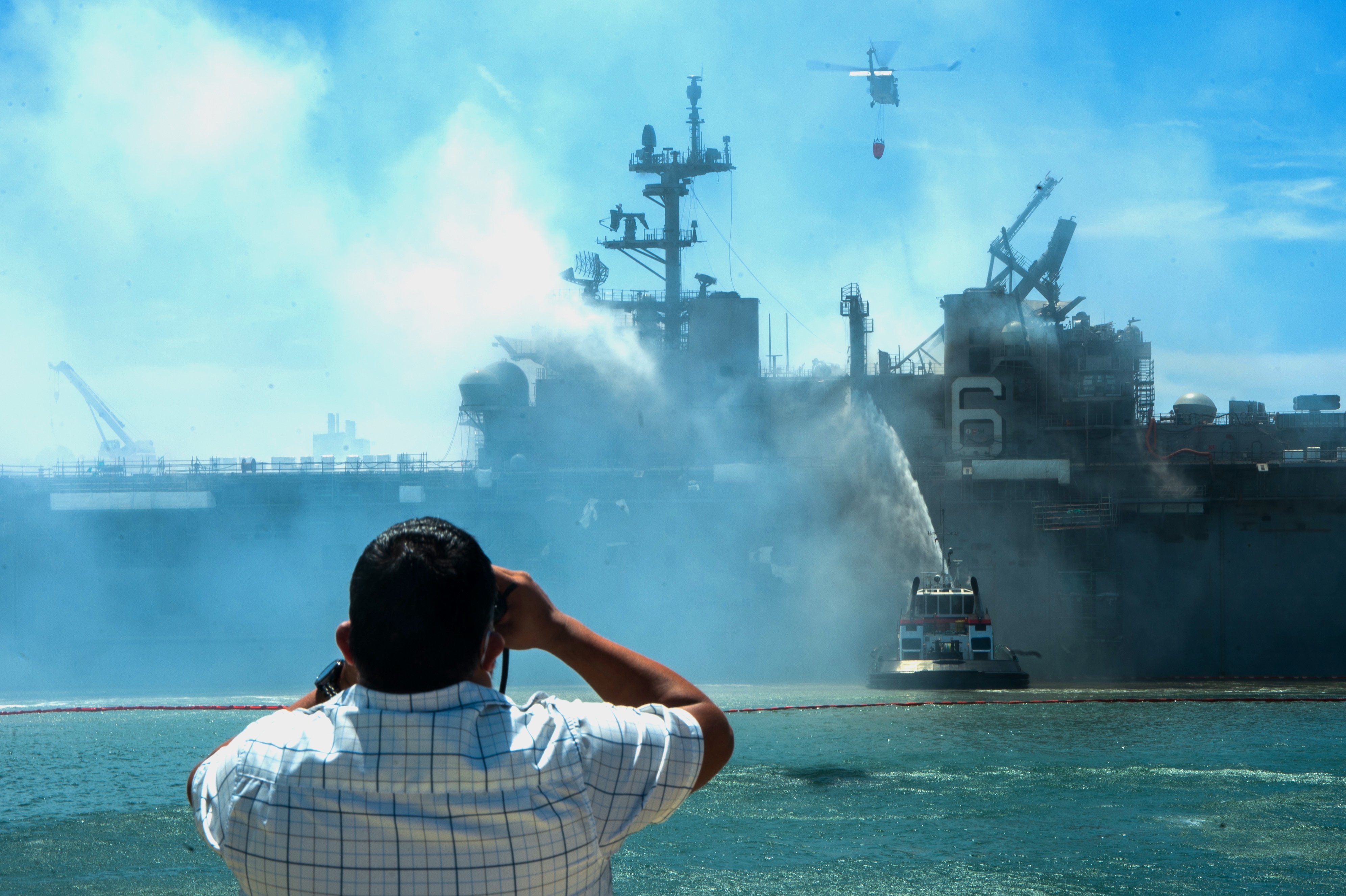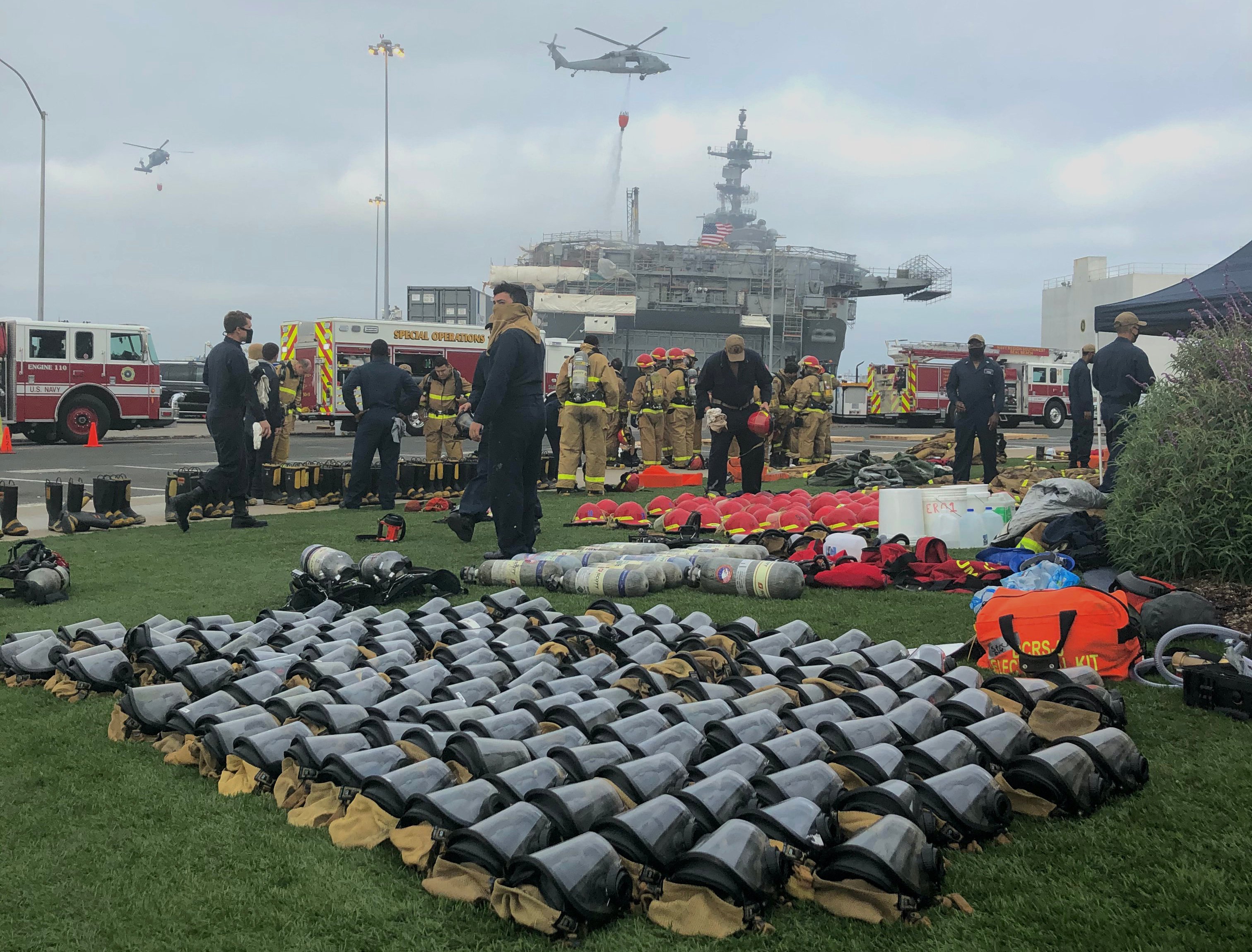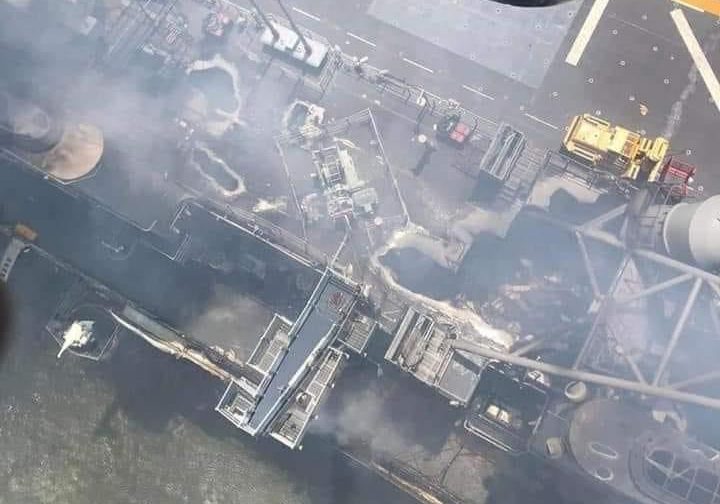
SAN DIEGO, Calif. – Sailors and firefighting crews are still battling two “major” fires aboard USS Bonhomme Richard (LHD-6), three days after a fire sparked and quickly spread throughout the amphibious assault ship, Navy officials said on Tuesday.
One of the fires is in the forward part of the ship, while the other is burning in the rear or aft portion, Rear Adm. Philip Sobeck, commander of the San Diego-based Expeditionary Strike Group 3, said during a morning press briefing at the naval base.
“We’ve got it now isolated to two main areas,” he said.
Firefighting crews just recently got access to the forward section, however, where that fire is burning from a new heat source. Fireboats have been pouring water into those spaces because fire crews had not been able to reach them.
“The one aft, we’re still investigating, but we’re just finding out its initial heat source and we want to investigate … is it an actual fire or was it a residual and still sort of smoking,” he said.
“We had not been able to make it up to the forward part of the ship as early as today,” he added. “And now that we have access to that area where we have that heat source – and we’re doing that investigation – and teams are there with water hoses to be able to start getting after that fire.”
“We’re still battling a major fire inside,” he added.
Sailors reported the initial fire in a lower vehicle and equipment stowage area about 8:30 a.m. Sunday, the Navy said, when about 160 members of the 1,000-member crew were aboard the ship, which was undergoing maintenance while berthed at Pier 2 at Naval Base San Diego. The ship was near the end of a lengthy, $249-million repair, maintenance and upgrade period that included modifications, done at the nearby General Dynamics NASSCO shipyard, to support the Marine Corps’ advanced F-35B Lightning II Joint Strike Fighter.
Despite the sailors’ efforts to attack the initial fire, it quickly spread. An explosion occurred that was heard around the base and created more debris that further fueled the fire. Sobeck said the explosion happened as the ship’s crew was attempting to activate the ship’s internal fire suppression system. It had been de-energized due to the ongoing maintenance work.
“Before they were able to energize the system, that’s when the explosion occurred,” he said. “They were buttoning up the area around it and were getting ready to activate that system. The explosion happened, and they had to egress.”

As the initial fire spread, flames found fresh fuel sources from the air and oxygen in the ship’s less-confined, more-open areas. On a Wasp-class ship like Bonhomme Richard, these spaces include the wide ramps leading up to the cavernous flight deck. The 847-foot ship, designed to carry and deploy 1,800 combat-loaded Marines and their vehicles and aircraft around the globe, presents a challenge for fire crews to access its maze of compartments, spaces and decks often connected by tight hatches and access points.
Photographs distributed by the Navy and circulating on social media show devastating damage to the ship’s superstructure and some interior spaces, including the vehicle storage decks and medical department.
“The challenges remaining are getting that fire out completely, and once that occurs, we’ll go space by space to make sure that each and every compartment is cool,” Sobeck said, noting that additional crews could then get into those spaces without requiring some of the heavy breathing and safety equipment.
“We’re very hopeful that our efforts are making progress to the point where we’ve isolated it into two distinct areas, and we’re just going to get after it until it’s out,” he said.
Tuesday morning brought a noticeable decrease in smoke coming from the ship as large water tugs shot water onto the ship. “It looks clearer from the outside,” Sobeck said, “but inside, we’re still fighting a major fire inside.” But he said he’s still hopeful. “We’re going to get this thing out… and save the ship.”

Some of the larger concerns – that the fire could potentially spread to the fuel tanks, and balance and ballast issues amid the water attack – seemed to ease on Tuesday.
“We investigated the four main engineering spaces and found no major damage,” Sobeck said in an opening statement at the press briefing.
“There is no threat to fuel tanks, which is well below any active fires or heat sources. The ship is stable, and the structure is safe.”
Aircrews with the “Merlins” of Helicopter Sea Combat Squadron 3 have made more than 1,200 water drops onto the fire in the aerial attack on the superstructure and flight deck, both of which have sustained significant, devastating damage. As of Tuesday morning, 38 sailors and 23 civilians had been treated for minor injuries, including smoke inhalation and heat exhaustion, and none remained hospitalized, officials said.
Sobeck said the Navy will do a “thorough” investigation of the fire to pinpoint the cause of the fire and assess the damage, and he said it was too early to determine the next steps in any repair and salvage of the ship.
“Right now, our focus remains on putting out the fire and keeping people safe,” he said.





